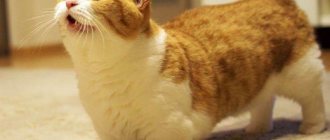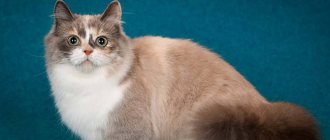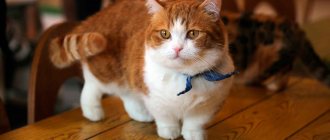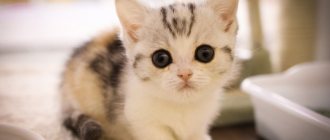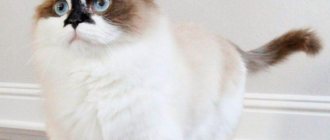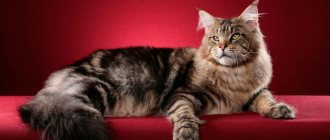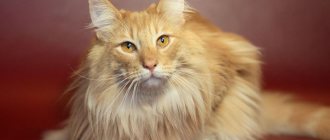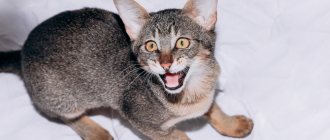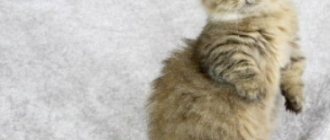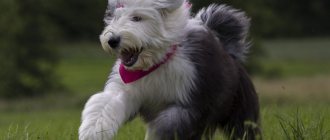History of the breed
The origin story begins in England in 1930, when the first 4 generations of kittens were born. However, during World War II the new breed was lost.
The next mention of a Munchkin cat appeared in 1983. In the state of Louisiana, American resident Sandra found and began caring for the last representative of the munchkins at that time.
Sandra's cat, named Brambleclaw, gave a new beginning to the emergence of a species that was little known at that time. Soon the cats that had been forgotten became some of the most popular members of the family.
The species received official recognition in 1985 in the USA, where munchkins were introduced and registered as a revived breed.
In 1991, the Munchkin breed was officially announced in the Tica show.
The breed, called the Munchkin, got its name in honor of the small people of the same name from Frank Baum's book "The Land of Oz."
Kinkaloe
Curled ears are a distinctive feature of the breed
One of the rarest breeds. In Russia, only one nursery is engaged in breeding these cats.
Kinkalows are the result of mating a Munchkin and an American Curl. The cats come from America; the first litter was born in 1996.
Character
Fast, slightly fussy and very active animals. There are practically no representatives of the breed in Russia, and talking with the owners of existing Kinkalows is a big problem. According to reviews of these cats, the animals are eternal “energizers”, like adult kittens. But one should not think that representatives of the breed retain childish behavior into old age, like Lambkins. Kinkaloos love to move and play, but inside the small, short cat lies real seriousness. Representatives of the breed categorically do not accept familiarity.
Health
Although Kinkalows are an experimental breed, their representatives are in good health. But problems caused by an unnaturally long spine cannot be ruled out.
Peculiarities
The main feature of the kinkalow is its ears. Small in size, curved, not at all like classic cat ears.
Description of the breed
The Munchkin is a breed of cat with short legs, pronounced Munchkin cat in English. The main characteristics of the individuals are squat, with very short straight legs and a long body, which distinguishes them from ordinary cats.
Representatives of the species have a wedge-shaped head, which is directly proportional to the body. In males, the head is more developed, which shows their superiority over females.
In addition to the structure of the head, the peculiarity of cats is the heaviness of the body. Males of the Munchkin cat breed differ from females in weight by 1-2 kilograms, reaching up to 4 kg, in contrast to the opposite sex, which has up to 3.5 kg. These pets can live up to 13 years, and in rare cases, up to 20.
Long-haired representatives have shiny fur with developed undercoat, which is present most of all on the legs, neck and tail. Shorthairs have a “plush” coat.
Reproduction and lifespan
When breeding a breed, you need to take into account many nuances. You should not engage in independent breeding without proper preparation. You need to be a professional who understands cat genetics.
Short-legged cats come in two types - standard and non-standard. The first ones have short legs, the second ones have long legs. If a kitten receives the gene for short legs from both parents, it will die as an embryo.
Munchkins should not be combined with breeds that have other strong mutation genes, as the offspring will be small and may even be incapacitated.
Munchkin breeding should be done by professionals
All new matings should improve the characteristics of the breed.
Seals reach sexual maturity at about one and a half years, and only then are they allowed to breed. Males can breed more often than females. A munchkin cat should give birth no more than twice a year. There are three or four kittens in a litter.
In three cities of Russia they professionally breed munchkins: Moscow, St. Petersburg and Novosibirsk.
If breeding is carried out by professionals, mating occurs under their supervision and all genetic risks are observed, then the cats will be born healthy and live long enough. On average, the life expectancy of munchkins is 13-16 years.
Appearance
The Munchkin and Dachshund breeds have the same genetic anomaly, which is well expressed in the structure of the body, expressed in direct proportion to the tail and body and the length of the paws.
Cats with short legs also differ:
- medium nose with a slightly noticeable deflection;
- strong neck;
- slightly visible forearms at the base of the forelimbs;
- a shaggy fluffy tail with a rounded tip - the difference between the long-haired individuals of this species;
- the eyes are shaped like a large walnut.
The eye color of these cats is rich, even in color and can easily differ from the color of the animal.
Popular colors
Among individuals of the munchkin color there are a variety of colors; strict standards for this characteristic have not been established. There are both long-haired cats and those with short hair. This is due to the natural nature of the mutation. If a breeder had intervened in the breed, the number of colors would have been limited.
Munchkins are compared to ordinary yard cats who were lucky enough to become famous due to their anomaly. At exhibitions you can see pets of colors ranging from bright red to solid gray. Tricolor, bicolor, as well as colors with spots and stripes are acceptable.
The breed is currently in its infancy. Perhaps, soon the requirements for standards will be tightened and the federations of felinologists will approve some specific colors.
Representatives of this color are often crossed with Scottish and Bengal cats. The result is short-legged “Scots” and “Bengalis”. In Berlin in 2022, a cat family was presented to the public, which is the result of mixing munchkins and sphinxes. These cats had short front legs, a miniature body and no hair.
Fans of the breed especially appreciate the chocolate and marbled colors. Such pets are born only in nurseries. With the current trend of kitten breeding, there will soon be a lot of chocolate and marbled animals.
Munchkin fold
Representatives of this breed differ in ear set from the existing standard, but cannot be recognized as a separate species. This is due to the presence of a risk of gene mutation and, as a result, health problems.
The Fold Munchkin or, as breeders call it, Folmax, is similar in appearance to the Scottish Fold cat due to genetic abnormalities in the skeleton and ear structure.
Interesting! The long-haired, fluffy Munchkin with very short legs, despite genetic abnormalities, has become popular among experienced breeders seeking to obtain a variety of options when crossing this species with other individuals of the family.
Chinese Cat Tank
In China, tanks are insanely expensive
A Chinese invention in felinology, called the “tank”. In fact, cute animals have nothing in common with a tank going forward and only forward.
The Chinese cat appeared as a result of crossing Minuets and British Shorthair cats. They first heard about tanks in 2008, and 6 years later cats gained incredible popularity in their homeland.
Character
Tanks, despite their name, are active and friendly creatures. Like most cats resulting from crossing munchkins with someone else, Chinese tanks have an enviable curiosity and a desire to climb. Therefore, owners of short-legged cats should not be surprised to find their pets on a high cabinet or on the refrigerator.
Character traits
The short-legged Munchkin cat has a friendly disposition and always finds a common language with other pets: the cat’s dogs will not see her as a rival.
The pet respects its owners and easily adapts to the mood. Strangers also quickly establish contact with the kitten after seeing its feline charm and kindness.
Walking around the room, they stomp their feet like hedgehogs, which also lifts the mood. The cheerful, playful, easy-going nature of the munchkin will not leave anyone indifferent.
These cats are curious and friendly, love to play and easily tolerate the “squeezing” of children, do not show aggression towards other pets, but can catch smaller animals: birds and rodents.
The presented description of the breed shows that understated Munchkin cats can easily make friends not only with an adult owner, but also with a child.
Nutrition
The short-legged Munchkin needs only a healthy and proper diet. It is advisable to include in his diet:
- meat - most of the diet should be from this product;
- vegetables, fish, eggs and cereals should be given 1-2 times a week.
All products must be selected carefully and ensure that the prepared food is low-fat. Due to the fact that your pet loves to eat, it is necessary to follow a feeding schedule, taking into account how active it is and in what physical shape. If the cat is fat, you need to slow down the pace of feeding and ask a specialist for advice on proper care of the animal.
Health
Representatives of this breed are in good health, but despite their excellent physical condition, they are plagued by back problems: lordosis, a disease expressed in the deflection of the spine due to weak muscles.
In addition to changing the position of the spine, this disease affects the heart and lungs - death is possible. To keep your cat healthy, you need to take it to the veterinarian and get the necessary vaccinations to prevent diseases.
It is possible to crossbreed only long-haired and short-haired representatives of the species in order to exclude deaths during the birth of kittens, as well as the transmission of life-threatening diseases.
Kitten in the house
In order for a munchkin kitten to appear in a family, you need to think about where you can buy a pet. When choosing a place of purchase, you should pay attention to nurseries and what breeders of this breed will offer, since Munchkin kittens in such places of sale will already be litter box trained and with the necessary vaccinations.
If you are not satisfied with the prices of breeders or kennels, you can use other places, such as exhibitions or online advertisements, but remember that there is a risk of buying a false munchkin.
A munchkin costs from 3 to 20 thousand rubles. The cost mainly depends on the color and age of the individual.
Summarizing all of the above, we point out that when the choice of pets is made, it must be conscious and made with maximum responsibility.
